HiPACC Data Science Press Room. From: UCR
The Data Science Press Room highlights computational and data science news in all fields *outside of astronomy* in the UC campuses and DOE laboratories comprising the UC-HiPACC consortium. The wording of the short summaries on this page is based on wording in the individual releases or on the summaries on the press release page of the original source. Images are also from the original sources except as stated. Press releases below appear in reverse chronological order (most recent first).
September 19, 2014 — Project launched to study evolutionary history of fungi
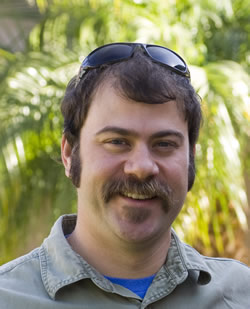
Jason Stajich is an associate professor of plant pathology and microbiology at UC Riverside. Credit: Stajich Lab/UC Riverside
UCR 9/19/2014—UC Riverside is one of 11 collaborating institutions that have received a total of $2.5 million from the National Science Foundation for a four-year project called the Zygomycete Genealogy of Life (ZyGoLife) focused on studying zygomycetes: ancient lineages of fungi used in numerous industrial processes and fermentation of foods. Thought to be among the first terrestrial fungi, zygomycetes represent one of the earliest origins of multicellular growth forms. Indeed, symbiotic associations with zygomycetes may have facilitated the origin of land plants. Their filamentous growth is in the form of the tube-like cell growth that characterizes species of fungi including bread and fruit molds, animal and human pathogens, and decomposers of a wide variety of organic compounds. Jason Stajich, associate professor of plant pathology and microbiology, is principal investigator. His UCR lab will be spearheading genome sequence analysis to better establish the family tree of fungi from these lineages and disseminating data into genomic databases such as MycoCosm of the Joint Genome Institute of the U.S. Department of Energy and FungiDB. The Stajich lab will also host visiting students and postdocs from the other teams to provide training in bioinformatics and evolutionary genomics in fungi.
View UCR Data Science Press Release
August 13, 2014 — Statistical model predicts performance of hybrid rice
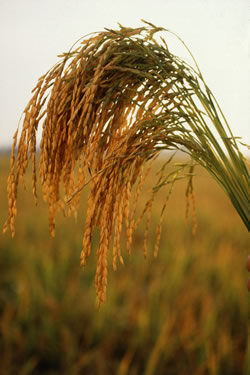
Long-grain rice. Credit: Keith Weller, USDA
UCR 8/13/2014—Genomic prediction, a new field of quantitative genetics, is a statistical approach to predicting the value of an economically important trait in a plant, such as yield or disease resistance. The method works if the trait is heritable, as many traits tend to be, and can be performed early in the life cycle of the plant, helping reduce costs. Now a research team led by plant geneticists at UC Riverside and Huazhong Agricultural University, China, has used the method to predict the performance of hybrid rice (for example, the yield, growth-rate and disease resistance). The new technology could potentially revolutionize hybrid breeding in agriculture. The study, published online in the August 26 issue of the Proceedings of the National Academy of Sciences, is a pilot research project on rice. The technology can be easily extended, however, to other crops such as maize.
View UCR Data Science Press Release
July 29, 2014 — 1996 research article deemed a classic paper

Michael Pazzani is the vice chancellor for research and economic development at UC Riverside. Credit: Carlos Puma
UCR 7/29/2014—A 1996 research paper authored by UC Riverside’s Michael J. Pazzani and two colleagues has been selected by the Association for the Advancement of Artificial Intelligence (AAAI) to win the 2014 Classic Paper Award. The AAAI, which promotes theoretical and applied artificial intelligence research, established the award in 1999 to honor authors of papers, chosen from a specific conference year, that were deemed most influential. The research paper is “Syskill & Webert: Identifying Interesting Web Sites,” published in the proceedings of The Thirteenth National Conference on Artificial Intelligence (AAAI-96). Pazzani’s coauthors are Jack Muramatsu and Daniel Billsus. Their paper showed how a profile of the user can be learned by any learning algorithm from a user’s feedback on any web page and how this profile can be used to predict the user’s interest in web pages. By combining the system with a search engine, the paper showed how search results can be personalized and how a query can be constructed to search for content that interests the user. The research paper directly led to commercial applications, and today the personalization of content on the internet may be the most common application of artificial intelligence encountered by the average person.
View UCR Data Science Press Release
July 1, 2014 — Nine junior faculty receive national recognition

The CAREER grant is one of the most prestigious awards given out by the National Science Foundation.
UCR 7/1/2014—Nine researchers at UC Riverside have been awarded National Science Foundation (NSF) CAREER grants in July 2013–June 2014. One of NSF’s most prestigious awards, the CAREER grant is targeted towards promising new faculty early in their careers, with the goal of providing stable support while they establish themselves as independent researchers and exceptional educators in their fields. Two of the researchers were in computational science. Chia-en Chang, an assistant professor of chemistry and bioinformatics, will use computer modeling to investigate complex interactions among molecules, including proteins, enzymes and nanoparticles. Juhi Jang, an associate professor of mathematics, will investigate physically important phenomena, such as the collapse of stars or generation of vortices at the interface between two fluids, based on partial differential equations (PDE) approaches.
View UCR Data Science Press Release
June 9, 2014 — Using Twitter to track flu, Lady Gaga

Screenshot of healthsocialytics.com web site developed by Vagelis Hristidis and his team at UC Riverside.
UCR 6/9/14—Interested in the number of tweets about the flu in recent days, weeks or months? Whether the tweets are positive or negative? How they are dispersed geographically down to the street level? Words commonly used with flu? Or, even, predicting of the number of tweets about the flu in the coming days? Health Social Analytics (healthsocialytics.com) —a web site developed by Vagelis Hristidis, UC Riverside associate professor of computer science and engineering—visualizes data about health-related disorders, drugs and organizations from Twitter, news stories, and online health forums such as WebMD. “This is a tool that brings the power of social and news big data to your fingertips,” Hristidis said. The tool has potential applications for a wide range of groups. Government agencies could use it when preparing for a public health emergency, such as the H1N1 (swine) flu scare in 2009–2010. Drug companies could use it to check the sentiment and volume of online chatter related to their drugs versus ones of their competitors. Health psychologists could use to learn what keywords dominate health-related forums or which disorders have the biggest online communities. Media outlets could use it to track health trends.
View UCR Data Science Press Release
May 19, 2014 — Chemists challenge conventional understanding of how photocatalysis works
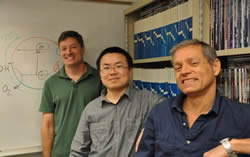
From right to left: Francisco Zaera, Yadong Yin and Christopher Bardeen. They are faculty members in the Department of Chemistry at UC Riverside. Credit: I. Pittalwala
UCR 5/19/14—Photocatalysis—catalysis assisted by light—is a promising route to convert solar energy into chemical fuels. Particularly appealing is the possibility to use photocatalysis to split water molecules into molecular hydrogen for use as a fuel to replace fossil fuels. Although photocatalysis has been around for many years, the search for viable photocatalysts to facilitate the splitting of water molecules continues to date. Photocatalysts are most often semiconductors, with precious metals such as platinum or gold added to promote their activity. However, such “promoter” metals are expensive. There is a need, therefore, to find more economical alternatives. Now a team of chemists at the University of California, Riverside has come up with a model to explain this promoting effect that could shift the focus in the search for substitutes of the metals and help identify better and more economical promoters for photocatalysis in the near future.
View UCR Data Science Press Release
May 15, 2014 — Funding From National Institutes of Health to Help Expand Data Storage Capacity on Campus

As computers have improved, growing storage and processing capacities have provided new and powerful ways to gain insight into the world by sifting through vast data sets. Credit: DARPA
UCR 5/15/14—Scientists at UC Riverside work on a variety of research topics critical to human health, such as genome biology, biomedical sciences, chemistry and computational biology. Next-generation sequencing and other high-throughput technologies routinely used in researching these topics generate vast amounts of data, increasing the need for high-performance computing. The campus has now received funding of $600,000 from the National Institutes of Health (NIH) to support data-intensive research — also often called Big Data science. Specifically, the grant will make possible the purchase of a complex instrument: a Big Data cluster with high-performance CPU resources and data storage space equivalent to 5,000 modern laptops.
View UCR Data Science Press Release
April 19, 2014 — Saving crops and people with bug sensors
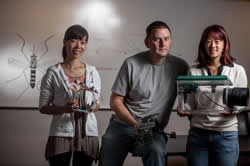
Yanping Chen, Eamonn Keogh, and Adena Why stand and hold insect sensor equipment. Credit: Peter Phun
UCR 4/19/14—UC Riverside researchers have created a method that can classify different species of insects with up to 99 percent accuracy, a development that could help farmers protect their crops from insect damage and limit the spread of insect-borne diseases, such as malaria and Dengue fever. Over the past 60 years, insect classification research has been limited by factors including an overreliance on acoustic sensing devices, a heavy focus on wingbeat frequency and limited data. The UC Riverside researchers overcame those limitations by building an inexpensive wireless bug sensor that can track many insect flight behavior patterns and generate much larger amounts of data that can then be incorporated into classification algorithms.
View UCR Data Science Press Release
March 16, 2014 — Climatologists offer explanation for widening of tropical belt
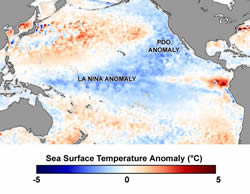
This image shows the sea surface temperature anomaly in the Pacific Ocean from April 14–21, 2008. For detailed information, see http://bit.ly/1olgQpr . Credit: NASA/Remote Sensing Systems
UCR 3/16/14—The Earth’s tropical belt—demarcated, roughly, by the Tropics of Cancer and Capricorn—has progressively expanded since at least the late 1970s. A team of climatologists, led by researchers at UC Riverside, analyzed climate models used by the Intergovernmental Panel on Climate Change (IPCC) Fifth Assessment Report (2014), several observational and re-analysis data sets, and conducted their own climate model experiments to quantify tropical widening, and to isolate the main cause. The team concludes that the recent widening of the tropical belt is primarily caused by multi-decadal sea surface temperature variability in the Pacific Ocean, due in part to anthropogenic pollutants. Their study was published March 16 in Nature Geoscience.
View UCR Data Science Press Release
April 4, 2014 — Scientists generate 3D structure for the malaria parasite genome
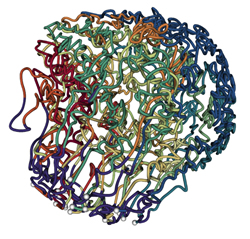
3D modeling of the human malaria parasite genome at one of the stages of its life cycle. Each color represents one of the 14 chromosomes of the parasite genome, the exception being purple (indicates genes known to be involved in virulence). (Credit: Le Roch Lab, UC Riverside)
UCR 4/4/14 — A research team led by a cell biologist at UC Riverside has generated a 3D model of the human malaria parasite genome at three different stages in the parasite’s life cycle—the first time such 3D architecture has been generated during the progression of the life cycle of any parasite. “Understanding the spatial organization of chromosomes is essential to comprehend the regulation of gene expression in any eukaryotic cell,” said Karine Le Roch, an associate professor of cell biology and neuroscience, who led the study. “Now we can more carefully search for components or drugs that can disrupt this organization, helping in the identification of new anti-malaria strategies.” According to the World Health Organization, an estimated 207 million people were infected with malaria in 2012 alone, leading to 627,000 deaths.
View UCR Data Science Press Release
March 31, 2014 — Where to get Viagra news? (Really, this isn’t spam)

Vagelis Hristidis, an associate professor of computer science and engineering, led a study of how people use social networks to find health information
UCR 3/31/14 — Do you want information on Viagra or ibuprofen? Check out general social networks such as Twitter and Pinterest. Interested in sleep disorders or depression? You’re better off going to specialized health social networks such as WebMD or drugs.com. That is one of the findings of a paper “Pharmaceutical Drugs Chatter on Online Social Networks,” based on an analysis of more than 1 million drug-related posts, by a team of researchers led by Vagelis Hristidis at UC Riverside’s Bourns College of Engineering and Department of Political Science. The findings have implications for a wide range of stakeholders.
View UCR Data Science Press Release










